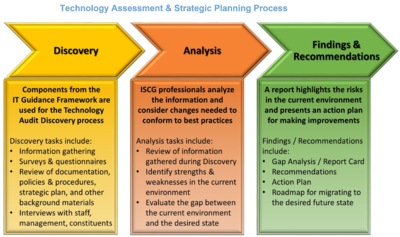Difference between revisions of "IT Strategic Planning"
| Line 4: | Line 4: | ||
[[File:Technology Assessment and Strategic Planning Process.png|400px|Technology Assessment and Strategic Planning Process]]<br /> | [[File:Technology Assessment and Strategic Planning Process.png|400px|Technology Assessment and Strategic Planning Process]]<br /> | ||
source: [https://iscgi.com/consulting/technology-assessments-and-strategic-technology-planning/ ISCG] | source: [https://iscgi.com/consulting/technology-assessments-and-strategic-technology-planning/ ISCG] | ||
| + | |||
| + | |||
| + | Roughly, IT Strategic Planning: | ||
| + | *Identifies committees to lead the work | ||
| + | *Sets a schedule and communicates the purpose and process | ||
| + | *Seeks and uses input from stakeholders with surveys and by meeting with campus groups, like the faculty senate, student leadership, and administrative groups | ||
| + | *Considers broader trends outside the institution | ||
| + | *Prioritizes IT goals and outlines initiatives/projects to reach those goals | ||
| + | *Aligns goals with the institution’s strategic plan | ||
| + | *Identifies resources needed to complete initiatives/projects | ||
| + | *Outlines a structure for implementing and reviewing the plan, creating a continual IT planning process | ||
| + | The maturity of your institution’s strategic planning process informs the scope of your IT strategic plan. For example, if your institution’s strategic plan is specific with statements like, “improve classroom technology for instruction and distance education,” then your IT plan becomes more operational than strategic. On the other hand, if an overall strategic plan is vague or nonexistent, your IT plan becomes more strategic.<ref>Explaining IT Strategic Planning [https://www.scup.org/planning-type/information-technology-planning/ Society for College and University Planning]</ref> | ||
Revision as of 18:39, 12 October 2021
IT Strategic Planning (aka Information Technology Strategic Planning) is the vehicle used to ensure that the organization is leveraging technology and technology enabled services, to create value for the organization, stakeholders, customers, and partners. IT Strategic Plans are the “on ramps” to arrive at short and long-term organizational objectives. Typically, getting to an IT Strategic Plan starts with a technology assessment or series of assessments to understand the current state of the organization and to define a roadmap and strategy for achieving the desired future state vision. This helps define a detailed strategy for driving the expected business outcomes associated with change or transformation initiatives.[1]

source: ISCG
Roughly, IT Strategic Planning:
- Identifies committees to lead the work
- Sets a schedule and communicates the purpose and process
- Seeks and uses input from stakeholders with surveys and by meeting with campus groups, like the faculty senate, student leadership, and administrative groups
- Considers broader trends outside the institution
- Prioritizes IT goals and outlines initiatives/projects to reach those goals
- Aligns goals with the institution’s strategic plan
- Identifies resources needed to complete initiatives/projects
- Outlines a structure for implementing and reviewing the plan, creating a continual IT planning process
The maturity of your institution’s strategic planning process informs the scope of your IT strategic plan. For example, if your institution’s strategic plan is specific with statements like, “improve classroom technology for instruction and distance education,” then your IT plan becomes more operational than strategic. On the other hand, if an overall strategic plan is vague or nonexistent, your IT plan becomes more strategic.[2]
- ↑ Definition - What Does IT Strategic Planning Mean? MSSBTA
- ↑ Explaining IT Strategic Planning Society for College and University Planning
